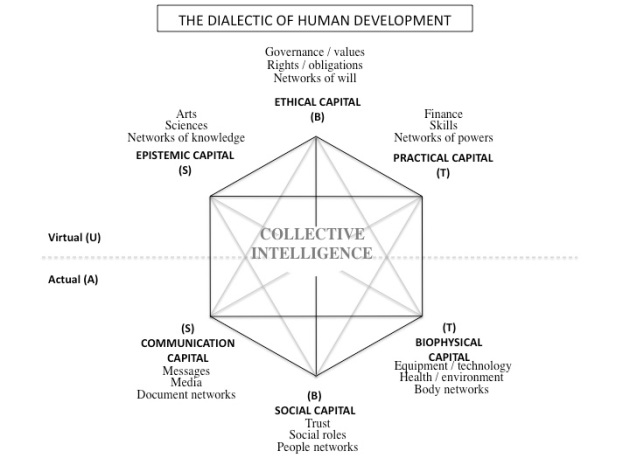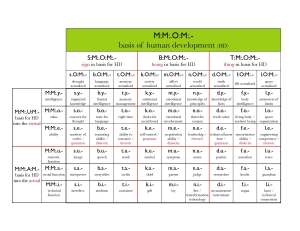E = Emptiness, U = Virtual, A = Actual, S = Sign, B = Being, T = Thing
This presentation of IEML dates back to 2014. A complete and up to date presentation can be found at https://intlekt.io/ieml/
The algorithmic medium
Before the algorithmic medium was the typographical medium (printing press, broadcasting) that industrialized and automated the reproduction of information. In the new algorithmic medium, information is, de facto, ubiquitous and automation now concentrates on the transformation of information.
The algorithmic medium is built from three interdependent components: the Web as a universal database (big data), the Internet as a universal computer (cloud), and the algorithms in the hands of people.
IEML (the Information Economy MetaLanguage) has been designed to exploit the full potential of the new algorithmic medium.
IEML, who and what is it for?
It would have been impossible to have designed IEML before the automatic-computing era and, a fortiori, to implement and use it. IEML was designed for digital natives, and built to take advantage of the new pervasive social computing supported by big data, the cloud and open algorithms.
IEML is a language
IEML is an artificial language that has the expressive power of any natural language (like English, French, Russian, Arabic, etc.). In other words, you can say in IEML whatever you want and its opposite, with varying degrees of precision.
IEML is an inter-linguistic semantic code
We can describe IEML as a sort of pivot language. Its reading/writing interface pops up in the the natural language that you want with an IEML text that self-translates in that specific language.
IEML is a semantic metadata system
IEML was also designed as a tagging system supporting semantic interoperability. Its main use is data categorization. As a universal system addressing concepts, IEML can complement the universal addressing of data on the Web and of processors on the Internet.
IEML is a programming language
An IEML text programs the construction of a semantic network in natural languages and it computes its relations and its semantic differences with other texts.
IEML is a symbolic system
As with any other symbolic systems, IEML is a result from the interaction of three interdependent layers of linguistic complexity: a syntax, semantics and pragmatics.
IEML syntax
IEML syntax is an algebraic topology: this means that a complex network of relations (topology) is coded by an algebraic expression.
IEML Algebra
IEML algebra is based on six basic variables {E, U, A, S, B, T} and two operations {+, ×}. The multiplication builds links (node A, node B, tag) and the addition operation creates graphs by connecting the links. The results of any algebraic operation can be used as a basis for new operations. This recursivity allows the construction of successive layers of complexity.
A computable Topology
Each distinct variable of the IEML algebra corresponds to a distinct graph. Given a set of variables, their relations and their semantic differences are computable.
IEML semantics
As it is projected onto an algebraic topology, IEML’s semantics becomes computable.
The semantic projection onto an algebraic topology
– An IEML script normalizes the notation of an algebraic expression.
– The IEML dictionary is organized as a set of paradigms, a paradigm being a semantic network of terms. Each IEML term can be translated in natural languages.
– With IEML operations {+, ×} and its recursivity, the IEML grammar allows the construction of morphemes, words, clauses, phrases, complex propositions, texts and hypertexts.
The grammatical algorithms
Embedded in IEML, any grammatical algorithms can compute:
– the intra-textual semantic network corresponding to an IEML text
– the translation of an IEML semantic network into any chosen natural language
– the inter-textual semantic network and the semantic differences corresponding to any set of IEML texts.
IEML pragmatics
IEML pragmatics is oriented towards self-organization and reflexive collective intelligence.
A new approach to data and social networks
When data are categorized in IEML, they self-organize into semantic networks and automatically compute their semantic relations and differences. Moreover, when communities engage in collaborative data curation using IEML, what they get in return is a simulated image of their collective intelligence process.
Modeling ideas as dynamic texts
We can model our collective intelligence into an evolving ecosystem of ideas. In this framework, an idea can be defined as the assembly of a concept, an affect, a percept (a sensory-motor image) and a social context. In a dynamic text, the concept is represented by an IEML text, the affect by credits (positive or negative), the percept by a multimedia dataset and the social context as an author (a player) a community (a semantic game) and a time-stamp.
Automatic computing of dynamic hypertexts
Thanks to IEML grammatical algorithms, any set of dynamic texts self-organizes into a dynamic hypertext that represents an ecosystem of ideas in the form of an immersive simulation. Now, a reflexive collective intelligence can emerge from a collaborative data curation.



[…] french and english « Confessions d’un Homo Faber. Pourquoi j’ai inventé #IEML IEML in a Nutshell […]
LikeLike
[…] construction of the algorithmic medium is ongoing. We are now ready to add a fourth layer of addressing and, this time, it will be a universal addressing system for semantic metadata. Why? First, we are […]
LikeLike
Sir, I want to say thank you. I genuinely pray you receive the credit you deserve for this most amazing work. I’m a college sophomore who had been working privately on precisely such as what you have here, and to see the finished product before I even got a quarter as far as you did in this work is an honor.
LikeLike
[…] since it describes words that already form a language of their own—that he calls IEML, or the Information Economy MetaLanguage. All that’s left is to do the actual coding to turn it into an automatic […]
LikeLike
Bonjour Pierre,
Avez-vous un bulletin d’information?
LikeLike
Pas encore! Mais vous pouvez me suivre sur Twitter @plevy
LikeLike
[…] de protocole. Elle est complémentaire d’autres idées que l’ont trouve entre autres ici et là dans le monde […]
LikeLike
[…] o kterém jsem psal v souvislosti s iniciativou vTaiwan a metajazyk IEML filosofa Pierra Lévyho, který dle všeho zanedlouho úspěšně dokáže automaticky vytvářet […]
LikeLike
This is some really great stuff : )
LikeLike
And there is even more at https://intlekt.io/ and https://intlekt.io/blog/ !
LikeLike